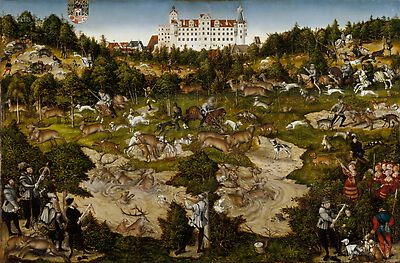| Frank 2018 |
151 fn. 105 |
|
Fig. 60 |
| Author | Katharina Frank |
|---|
| Title | Die biblischen Historiengemälde der Cranach-Werkstatt. Christus und die Ehebrecherin als lehrreiche 'Historie' im Zeitalter der Reformation |
|---|
| Place of Publication | Heidelberg |
|---|
| Year of Publication | 2018 |
|---|
|
| Exhib. Cat. Gotha, Kassel 2015 |
236, 237 |
074 |
Pl. p. 237 |
| Editor | Julia Carrasco, Justus Lange, Benjamin D. Spira, Timo Trümper, Stiftung Schloss Friedenstein, Gotha |
|---|
| Title | Bild und Botschaft. Cranach im Dienst von Hof und Reformation, [Gotha, Herzogliches Museum; Kassel, Gemäldegalerie Alte Meister, Schloss Wilhelmshöhe] |
|---|
| Place of Publication | Heidelberg |
|---|
| Year of Publication | 2015 |
|---|
|
| Trümper 2015 A |
24 |
|
|
| Author | Timo Trümper |
|---|
| Title | Inszenierungsstrategien der Ernestiner |
|---|
| Publication | in Julia Carrasco, Justus Lange, Benjamin D. Spira, Timo Trümper, Stiftung Schloss Friedenstein Gotha and Museumslandschaft Hessen Kassel, eds., Bild und Botschaft. Cranach im Dienst von Hof und Reformation, [Exhib. Cat. Gotha, Kassel] |
|---|
| Place of Publication | Heidelberg |
|---|
| Year of Publication | 2015 |
|---|
| Pages | 17-28 |
|---|
|
| Werner 2015 |
9 |
|
|
| Author | Elke Anna Werner |
|---|
| Title | Lucas Cranach der Jüngere und die Reformation der Bilder. Zur Einführung |
|---|
| Publication | in Elke A. Werner, Anne Eusterschulte, Gunnar Heydenreich, eds., Lucas Cranach der Jüngere und die Reformation der Bilder |
|---|
| Place of Publication | Munich |
|---|
| Year of Publication | 2015 |
|---|
| Pages | 8-16 |
|---|
|
| CDA.Bloh 2005 |
177 |
|
|
| Author | Jutta Charlotte von Bloh |
|---|
| Title | Kleidung und Waffen in den Fürstenbildnissen der Cranachs |
|---|
| Publication | in Harald Marx, Ingrid Mössinger, Karin Kolb, eds., Cranach, Exhib. Cat. Chemnitz 2005 |
|---|
| Place of Publication | Cologne |
|---|
| Year of Publication | 2005 |
|---|
| Pages | 174-181 |
|---|
|
| Pérez d'Ors 2005 |
6-19 |
|
|
| Author | Pablo Pérez d'Ors |
|---|
| Title | Dos Cacerás de Lucas Cranach el Viejo en el Museo del Prado. Nuevos datos sobre las dos escenas de caza: historia material, obras similares y claves para su interpretación iconográfica e iconológica |
|---|
| Journal | Boletín del Museo del Prado |
|---|
| Issue | 23, No.. 41 |
|---|
| Year of Publication | 2005 |
|---|
| Pages | 6-22 |
|---|
|
| Exhib. Cat. Kronach 1994 |
311 |
|
|
| Editor | Claus Grimm, Johannes Erichsen, Evamaria Brockhoff |
|---|
| Title | Lucas Cranach. Ein Maler-Unternehmer aus Franken [Festung Rosenberg, Kronach 17.05 - 21.08.1994; Museum der Bildenden Künste, Leipzig 07.09 - 06.11.1994] |
|---|
| Series | Veröffentlichungen zur bayerischen Geschichte und Kultur |
|---|
| Volume | 26 |
|---|
| Place of Publication | Augsburg, Coburg |
|---|
| Year of Publication | 1994 |
|---|
|
| Friedländer, Rosenberg 1979 |
|
No. 411 |
|
| Author | Max J. Friedländer, Jakob Rosenberg |
|---|
| Editor | G. Schwartz |
|---|
| Title | Die Gemälde von Lucas Cranach |
|---|
| Place of Publication | Basel, Boston, Stuttgart |
|---|
| Year of Publication | 1979 |
|---|
|
| Schade 1974 |
209-211 |
|
|
|
|
| Friedländer, Rosenberg 1932 |
90 |
330 |
|
|
|
